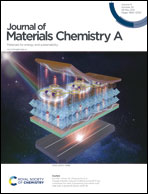Stabilization of lithium metal anodes by conductive metal–organic framework architectures†
Abstract
Lithium (Li) metal, with its high energy density, is auspicious for use in Li-ion batteries. However, the ubiquitous problem of Li dendrite formation on Li metal anodes during cycling remains unresolved and impedes their practical utilization in multitudinous scenarios. Herein, we propose an alternative strategy to address the challenge above via the fabrication of Ni3(2,3,6,7,10,11-hexaiminotriphenylene)2-modified Cu-foil (Ni3(HITP)2@Cu-foil) current collectors to provide “honeycomb”-like architectures without sacrificing Li-ion transport. The large specific surface area and layered crystallographic nature of Ni3(HITP)2 afford fast and homogeneous transport channels of Li ions and a lower local current density. Meanwhile, the lithiophilic nitrogen (N)-containing functional groups (pyridinic and pyrrolic N) in Ni3(HITP)2 exhibit good lithium affinity and therefore endow uniform nucleation and growth of the metallic Li on the current collectors. These claims were verified by microscopic imaging and density functional theory (DFT) calculations. Hence, the formation of Li dendrites during Li plating/stripping processes can be circumvented. Concomitantly, the Ni3(HITP)2 modified Cu-foil anodes show high coulombic efficiency of 99.7% after nearly 1000 cycles compared with Li/graphite@Cu-foil, Li/Ni-NDC@Cu-foil, and Li/Cu-foil in half-cell systems. This study sheds light on the rational design of current collectors via a combination of novel conductive metal–organic frameworks for stabilizing Li metal anodes.



 Please wait while we load your content...
Please wait while we load your content...